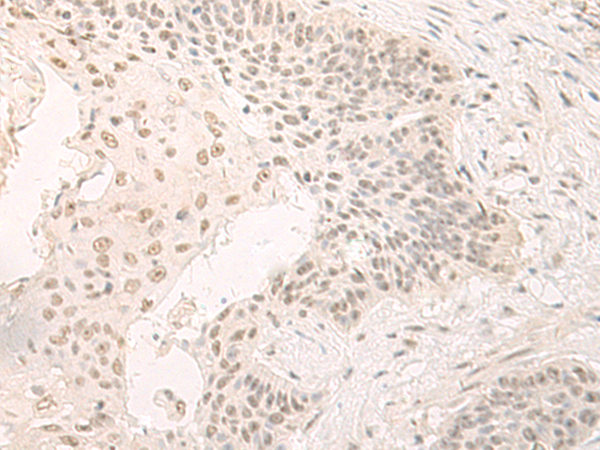


| WB | 咨询技术 | Human,Mouse,Rat |
| IF | 咨询技术 | Human,Mouse,Rat |
| IHC | 1/30-1/150 | Human,Mouse,Rat |
| ICC | 技术咨询 | Human,Mouse,Rat |
| FCM | 咨询技术 | Human,Mouse,Rat |
| Elisa | 1/5000-1/10000 | Human,Mouse,Rat |
| Aliases | ESG; ESG1; GRG1 |
| WB Predicted band size | 83 kDa |
| Host/Isotype | Rabbit IgG |
| Antibody Type | Primary antibody |
| Storage | Store at 4°C short term. Aliquot and store at -20°C long term. Avoid freeze/thaw cycles. |
| Species Reactivity | Human, Mouse |
| Immunogen | Fusion protein of human TLE1 |
| Formulation | Purified antibody in PBS with 0.05% sodium azide and 50% glycerol. |
+ +
以下是关于TLE1抗体的3篇参考文献及其摘要概括:
---
1. **文献名称**:*"The role of TLE1 as a diagnostic immunohistochemical marker in synovial sarcoma"*
**作者**:Terry J. Smith, Julia A. Bridge
**摘要**:本研究评估了TLE1抗体在滑膜肉瘤(SS)诊断中的特异性与敏感性。通过对200例软组织肿瘤(包括滑膜肉瘤、恶性周围神经鞘瘤等)的免疫组化分析,发现TLE1在超过90%的滑膜肉瘤中呈核阳性,而在其他肉瘤中阳性率较低,提示TLE1可作为滑膜肉瘤的可靠标志物。
---
2. **文献名称**:*"TLE1 expression in malignant peripheral nerve sheath tumors and synovial sarcoma: a comparative study"*
**作者**:D. López-Terrada, et al.
**摘要**:文章比较了TLE1在滑膜肉瘤(SS)与恶性周围神经鞘瘤(MPNST)中的表达差异。结果显示,TLE1在滑膜肉瘤中高表达(85%阳性),而MPNST中几乎不表达,支持其在鉴别这两种组织学相似肿瘤中的诊断价值。
---
3. **文献名称**:*"Utility of TLE1 and CD99 immunohistochemistry in differentiating synovial sarcoma from other spindle cell neoplasms"*
**作者**:Jorge S. Reis-Filho, et al.
**摘要**:研究探讨了TLE1与CD99联合应用在滑膜肉瘤诊断中的作用。TLE1单独诊断的特异性达95%,与CD99联合后可进一步提高准确性,减少与其他梭形细胞肿瘤(如纤维肉瘤)的误诊。
---
这些文献聚焦于TLE1抗体在肿瘤病理诊断(尤其是滑膜肉瘤)中的应用,涵盖其特异性、敏感性和鉴别诊断价值。如需具体文献,建议通过PubMed或学术数据库检索标题或作者以获取全文。
The TLE1 (Transducin-like enhancer of split 1) antibody is a tool used to detect the TLE1 protein, a member of the Groucho/Transducin-like enhancer of split (TLE) family. TLE1 functions as a transcriptional corepressor, regulating gene expression by interacting with transcription factors, such as those in the Wnt and Notch signaling pathways. Structurally, TLE1 contains an N-terminal Q domain for protein interactions and a C-terminal WD40 repeat domain critical for forming multiprotein complexes. It plays roles in embryonic development, cell differentiation, and tumorigenesis.
In diagnostic pathology, TLE1 antibodies are valuable for identifying synovial sarcoma, a soft-tissue malignancy. TLE1 is overexpressed in >95% of synovial sarcomas, making it a sensitive marker for distinguishing this tumor from histologically similar neoplasms. Immunohistochemistry (IHC) using TLE1 antibodies is routinely employed in clinical settings. However, specificity challenges exist, as TLE1 may also be expressed in other tumors, such as malignant peripheral nerve sheath tumors or solitary fibrous tumors, necessitating correlation with other markers (e.g., SS18-SSX fusion detection).
Research applications include studying TLE1's role in cancer progression, epigenetic regulation, and signaling pathways. Its involvement in repressing tumor suppressor genes or modulating oncogenic pathways like Hedgehog highlights its therapeutic relevance. Despite its utility, antibody performance can vary, emphasizing the need for validation in specific experimental or diagnostic contexts.
×